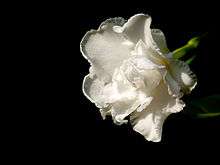Tabernaemontana divaricata
| Tabernaemontana divaricata | |
|---|---|
 | |
| Scientific classification | |
| Kingdom: | Plantae |
| (unranked): | Angiosperms |
| (unranked): | Eudicots |
| (unranked): | Asterids |
| Order: | Gentianales |
| Family: | Apocynaceae |
| Subfamily: | Rauvolfioideae |
| Genus: | Tabernaemontana |
| Species: | T. divaricata |
| Binomial name | |
| Tabernaemontana divaricata R.Br. ex Roem. & Schult. | |
| Synonyms[1] | |
|
List
| |
Tabernaemontana divaricata (Apocynaceae), commonly called pinwheelflower,[2] crape jasmine, East India rosebay and Nero's crown[3] is an evergreen shrub probably native to India and now cultivated throughout South East Asia and the warmer regions of continental Asia. In zones where it is not hardy it is grown as a house/glasshouse plant for its attractive flowers and foliage. The stem exudes a milky latex when broken, whence the name Milk Flower (দুধফুল), টগর or কাঠমল্লিকা in the Bengali language..It is known as நந்தியார்வட்டை "Nandiar vattai" in Tamil. It is known as wathusudda වතුසුද්ද (meaning "garden white") in the Sinhalese language. In the Kannada language its called Nandi battalu [ನಂದಿ ಬಟ್ಟಲು], Telugu language it's called nandivardhanam [నందివర్దనం]. Other Indian names include chandni and taggar. In Cambodia, it is called phka nuon srei ផ្កានួនស្រី or phka dâk khut ផ្កាដកឃុត.[4] The plant contains several alkaloids and, like many other Apocynaceae, is toxic and medicinal.
Description
The plant generally grows to a height of 5–6 feet (1.5–1.8 m) and is dichotomously-branched. The large shiny leaves are deep green and about 6 inches (15 cm) in length and 2 inches (5.1 cm) in width. The waxy blossoms are found in small clusters on the stem tips. The (single) flowers have the characteristic 'pinwheel' shape also seen in other genera in the family Apocynaceae such as Vinca and Nerium. Both single and double-flowered forms are cultivated, the flowers of both forms being white. The plant blooms in spring but flowers appear sporadically all year. The flowers of the single form are unscented but the double-flowered form has a pleasing fragrance.[5]
The leaves of this plant are eaten by the caterpillars of Oleander Hawk-moth Daphnis nerii
 Tabernaemontana divaricata 'Flore Pleno'
Tabernaemontana divaricata 'Flore Pleno' Tabernaemontana divaricata 'Pinwheel'
Tabernaemontana divaricata 'Pinwheel' Tabernaemontana divarcata yet to blossom
Tabernaemontana divarcata yet to blossom
Medicinal use
The roots have a bitter taste. They are used in Ayurvedic medicine as an anthelmintic for ascariasis and a treatment for scabies. The young stems are also good for the teeth, the latex being applied, on a cotton pellet, to teeth with dental caries.[6]
In mainland South East Asia an infusion of the roots is used as an antipyretic. In the Malay Peninsula a sweetened infusion of the leaves is used as a cough medicine, the pounded roots are applied externally for eye diseases (unspecified) and an unspecified part of the plant is mixed with other herbs to make a medicinal snuff for treating nasal ulcers. In Indonesia a decoction is used as an astringent anti-diarrheal. On Ambon Island the root is used to treat internal poisoning (poison unspecified), kidney stones and (in combination with two other plants) lumbago. On the Mentawai Islands, west of Sumatra, the latex is one of the ingredients in an arrow poison.
The plant has been reported to contain a variety of alkaloids, including, in the bark of the stem and root: tabernaemontanine, coronarine, coronaridine and dregamine. Of these, coronaridine shows promise as a potential treatment for opiate and cocaine addictions. Alkaloids are present in all the vegetative parts of this shrub.[7]
References
- ↑ "The Plant List: A Working List of All Plant Species".
- ↑ "Tabernaemontana divaricata". Natural Resources Conservation Service PLANTS Database. USDA. Retrieved 7 December 2015.
- ↑ Medicinal Plants of India and Pakistan, Dastur J.F., pub.1962 by D.P. Taraporevala Sons and Co. Private Ltd., Mumbai, 4th Indian reprint 1977
- ↑ Mathieu LETI, HUL Sovanmoly, Jean-Gabriel FOUCHÉ, CHENG Sun Kaing & Bruno DAVID, Flore photographique du Cambodge, Toulouse, Éditions Privat, 2013, p. 97.
- ↑ The Royal Horticultural Society Dictionary of Gardening ed. Chittenden,Fred J. 2nd ed. by Synge,Patrick M. Volume IV : Pt-Zy, p.2074 (as T. coronaria). Pub. Oxford at the Clarendon Press 1965. Reprinted 1984. ISBN 0-19-869106-8
- ↑ Ethnomedicinal Practices for Oral Health and Hygiene of Tribal Populations of Wayanad, Kerala Deepha K.C., Maji Jose, Vishnudas Prabhu International Journal of Research in Ayurveda and Pharmacy, 2(4), 2011 pps.146-150.
- ↑ Medicinal Plants of East and Southeast Asia: Attributed Properties and Uses, compiled by Perry, Lily M. with the assistance of Metzger, Judith, published by MIT Press 1980. ISBN 0-262-16076-5
External links
| Wikispecies has information related to: Tabernaemontana divaricata |
| Wikimedia Commons has media related to Tabernaemontana divaricata. |